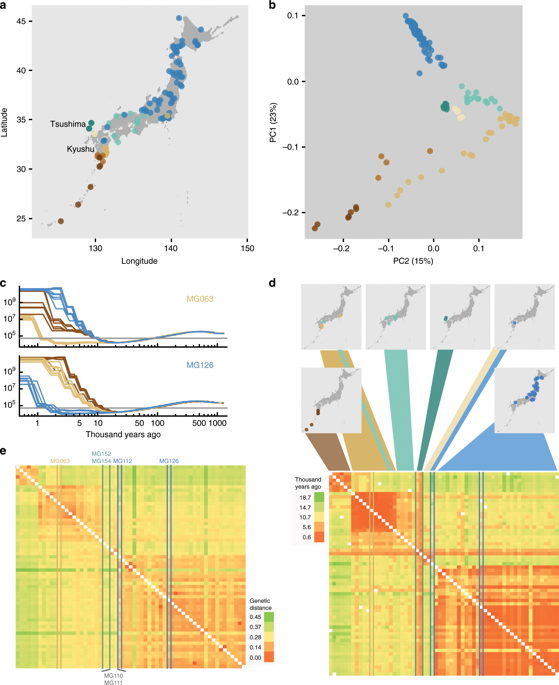当前位置:
X-MOL 学术
›
Nat. Commun.
›
论文详情
Our official English website, www.x-mol.net, welcomes your
feedback! (Note: you will need to create a separate account there.)
Extreme genetic signatures of local adaptation during Lotus japonicus colonization of Japan.
Nature Communications ( IF 14.7 ) Pub Date : 2020-01-14 , DOI: 10.1038/s41467-019-14213-y Niraj Shah 1 , Tomomi Wakabayashi 2 , Yasuko Kawamura 3 , Cathrine Kiel Skovbjerg 1 , Ming-Zhuo Wang 3 , Yusdar Mustamin 3 , Yoshiko Isomura 3 , Vikas Gupta 1 , Haojie Jin 1 , Terry Mun 1 , Niels Sandal 1 , Fuyuki Azuma 4 , Eigo Fukai 4 , Ümit Seren 5 , Shohei Kusakabe 3 , Yuki Kikuchi 3 , Shogo Nitanda 3 , Takashi Kumaki 3 , Masatsugu Hashiguchi 6 , Hidenori Tanaka 6 , Atsushi Hayashi 7 , Mads Sønderkær 8 , Kaare Lehmann Nielsen 8 , Korbinian Schneeberger 9 , Bjarni Vilhjalmsson 10 , Ryo Akashi 6 , Jens Stougaard 1 , Shusei Sato 3 , Mikkel Heide Schierup 11 , Stig Uggerhøj Andersen 1
Nature Communications ( IF 14.7 ) Pub Date : 2020-01-14 , DOI: 10.1038/s41467-019-14213-y Niraj Shah 1 , Tomomi Wakabayashi 2 , Yasuko Kawamura 3 , Cathrine Kiel Skovbjerg 1 , Ming-Zhuo Wang 3 , Yusdar Mustamin 3 , Yoshiko Isomura 3 , Vikas Gupta 1 , Haojie Jin 1 , Terry Mun 1 , Niels Sandal 1 , Fuyuki Azuma 4 , Eigo Fukai 4 , Ümit Seren 5 , Shohei Kusakabe 3 , Yuki Kikuchi 3 , Shogo Nitanda 3 , Takashi Kumaki 3 , Masatsugu Hashiguchi 6 , Hidenori Tanaka 6 , Atsushi Hayashi 7 , Mads Sønderkær 8 , Kaare Lehmann Nielsen 8 , Korbinian Schneeberger 9 , Bjarni Vilhjalmsson 10 , Ryo Akashi 6 , Jens Stougaard 1 , Shusei Sato 3 , Mikkel Heide Schierup 11 , Stig Uggerhøj Andersen 1
Affiliation

|
Colonization of new habitats is expected to require genetic adaptations to overcome environmental challenges. Here, we use full genome re-sequencing and extensive common garden experiments to investigate demographic and selective processes associated with colonization of Japan by Lotus japonicus over the past ~20,000 years. Based on patterns of genomic variation, we infer the details of the colonization process where L. japonicus gradually spread from subtropical conditions to much colder climates in northern Japan. We identify genomic regions with extreme genetic differentiation between northern and southern subpopulations and perform population structure-corrected association mapping of phenotypic traits measured in a common garden. Comparing the results of these analyses, we find that signatures of extreme subpopulation differentiation overlap strongly with phenotype association signals for overwintering and flowering time traits. Our results provide evidence that these traits were direct targets of selection during colonization and point to associated candidate genes.
中文翻译:

日本莲花定殖期间局部适应的极端遗传特征。
预计新栖息地的殖民化需要进行基因改造以克服环境挑战。在这里,我们使用完整的基因组重新测序和广泛的普通花园实验来研究在过去约20,000年中与日本莲Lotus定殖有关的人口统计和选择性过程。根据基因组变异的模式,我们推断出日本L. japonicus逐渐从亚热带条件向日本北部更为寒冷的气候蔓延的定殖过程的细节。我们确定在北部和南部的亚群之间具有极端遗传分化的基因组区域,并执行在公共花园中测量的表型性状的种群结构校正关联映射。比较这些分析的结果,我们发现,极端亚群分化的特征与越冬和开花时间性状的表型关联信号强烈重叠。我们的结果提供了证据,这些特征是定居过程中直接选择的目标,并指向相关的候选基因。
更新日期:2020-01-14
中文翻译:

日本莲花定殖期间局部适应的极端遗传特征。
预计新栖息地的殖民化需要进行基因改造以克服环境挑战。在这里,我们使用完整的基因组重新测序和广泛的普通花园实验来研究在过去约20,000年中与日本莲Lotus定殖有关的人口统计和选择性过程。根据基因组变异的模式,我们推断出日本L. japonicus逐渐从亚热带条件向日本北部更为寒冷的气候蔓延的定殖过程的细节。我们确定在北部和南部的亚群之间具有极端遗传分化的基因组区域,并执行在公共花园中测量的表型性状的种群结构校正关联映射。比较这些分析的结果,我们发现,极端亚群分化的特征与越冬和开花时间性状的表型关联信号强烈重叠。我们的结果提供了证据,这些特征是定居过程中直接选择的目标,并指向相关的候选基因。











































 京公网安备 11010802027423号
京公网安备 11010802027423号